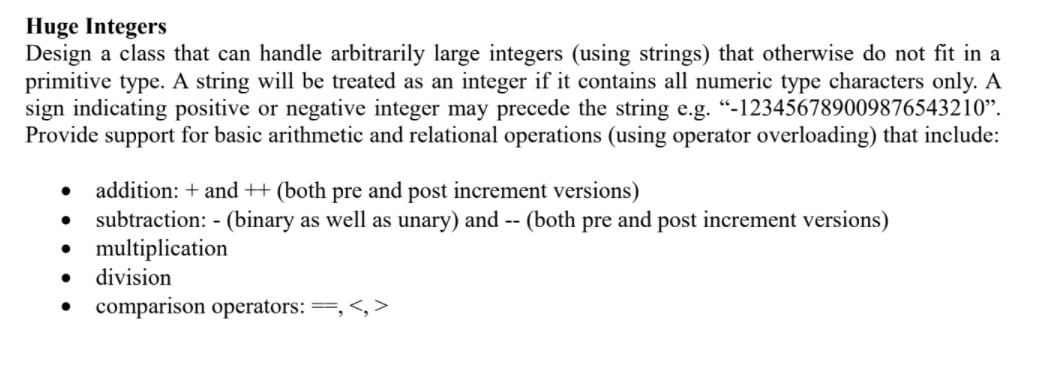Huge Integers Design a class that can handle arbitrarily large integers (using strings) that otherwise do not fit in a primitive type. A string will be treated as an integer if it contains all numeric type characters only. A sign indicating positive or negative integer may precede the string e.g. "-123456789009876543210". Provide support for basic arithmetic and relational operations (using operator overloading) that include: addition: + and + (both pre and post increment versions) subtraction: - (binary as well as unary) and -- (both pre and post increment versions) multiplication division comparison operators: ==, <, >
Huge Integers Design a class that can handle arbitrarily large integers (using strings) that otherwise do not fit in a primitive type. A string will be treated as an integer if it contains all numeric type characters only. A sign indicating positive or negative integer may precede the string e.g. "-123456789009876543210". Provide support for basic arithmetic and relational operations (using operator overloading) that include: addition: + and + (both pre and post increment versions) subtraction: - (binary as well as unary) and -- (both pre and post increment versions) multiplication division comparison operators: ==, <, >
Computer Networking: A Top-Down Approach (7th Edition)
7th Edition
ISBN:9780133594140
Author:James Kurose, Keith Ross
Publisher:James Kurose, Keith Ross
Chapter1: Computer Networks And The Internet
Section: Chapter Questions
Problem R1RQ: What is the difference between a host and an end system? List several different types of end...
Related questions
Question

Transcribed Image Text:Huge Integers
Design a class that can handle arbitrarily large integers (using strings) that otherwise do not fit in a
primitive type. A string will be treated as an integer if it contains all numeric type characters only. A
sign indicating positive or negative integer may precede the string e.g. “-123456789009876543210".
Provide support for basic arithmetic and relational operations (using operator overloading) that include:
addition: + and + (both pre and post increment versions)
subtraction: - (binary as well as unary) and -- (both pre and post increment versions)
multiplication
division
comparison operators: ==, <, >
Expert Solution
This question has been solved!
Explore an expertly crafted, step-by-step solution for a thorough understanding of key concepts.
This is a popular solution!
Trending now
This is a popular solution!
Step by step
Solved in 2 steps with 1 images

Recommended textbooks for you

Computer Networking: A Top-Down Approach (7th Edi…
Computer Engineering
ISBN:
9780133594140
Author:
James Kurose, Keith Ross
Publisher:
PEARSON

Computer Organization and Design MIPS Edition, Fi…
Computer Engineering
ISBN:
9780124077263
Author:
David A. Patterson, John L. Hennessy
Publisher:
Elsevier Science

Network+ Guide to Networks (MindTap Course List)
Computer Engineering
ISBN:
9781337569330
Author:
Jill West, Tamara Dean, Jean Andrews
Publisher:
Cengage Learning

Computer Networking: A Top-Down Approach (7th Edi…
Computer Engineering
ISBN:
9780133594140
Author:
James Kurose, Keith Ross
Publisher:
PEARSON

Computer Organization and Design MIPS Edition, Fi…
Computer Engineering
ISBN:
9780124077263
Author:
David A. Patterson, John L. Hennessy
Publisher:
Elsevier Science

Network+ Guide to Networks (MindTap Course List)
Computer Engineering
ISBN:
9781337569330
Author:
Jill West, Tamara Dean, Jean Andrews
Publisher:
Cengage Learning

Concepts of Database Management
Computer Engineering
ISBN:
9781337093422
Author:
Joy L. Starks, Philip J. Pratt, Mary Z. Last
Publisher:
Cengage Learning

Prelude to Programming
Computer Engineering
ISBN:
9780133750423
Author:
VENIT, Stewart
Publisher:
Pearson Education

Sc Business Data Communications and Networking, T…
Computer Engineering
ISBN:
9781119368830
Author:
FITZGERALD
Publisher:
WILEY